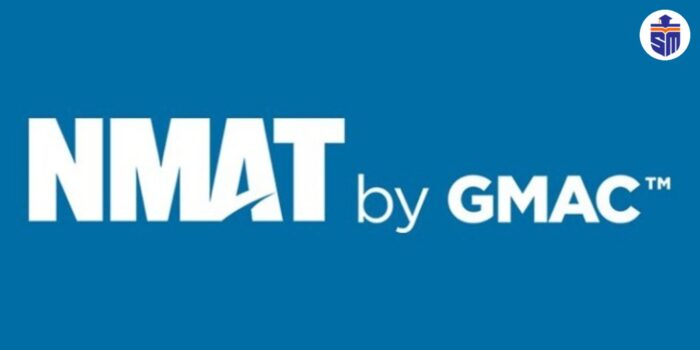
NMAT by GMAC – Comprehensive Guide
The NMAT (NMIMS Management Aptitude Test) by GMAC is a computer-based entrance exam administered by the Graduate Management Admission Council (GMAC) for admission to MBA and other management programs at NMIMS University and several other top business schools across India. Originally developed for NMIMS (Narsee Monjee Institute of Management Studies), the exam has gained wider acceptance and is now recognized by over 40 leading B-schools in India.
NMAT Exam Pattern
- Mode: Computer-Based Test (CBT)
- Duration: 120 minutes (2 hours)
- Total Questions: 108
- Sections Covered:
- Language Skills (36 questions, 28 minutes)
- Quantitative Skills (36 questions, 52 minutes)
- Logical Reasoning (36 questions, 40 minutes)
- Marking Scheme:
- +1 for each correct answer
- No negative marking
- Sectional Time Limit: Strict sectional time limits
- Test Window: 75-day testing window (typically October to December)
- Multiple Attempts: Up to 3 attempts allowed in one testing season
- Score Validity: 1 year
NMAT Syllabus and Important Topics
1. Language Skills (36 questions, 28 minutes)
This section tests verbal ability and English language proficiency:
- Reading Comprehension (2-3 passages)
- Para Jumbles
- Vocabulary (Synonyms/Antonyms)
- Fill in the Blanks
- Grammar & Sentence Correction
- Para Completion
- Idioms & Phrases
- Verbal Reasoning
- Analogies & Inference-based Questions
- Sentence Completion
2. Quantitative Skills (36 questions, 52 minutes)
This section tests mathematical ability and data interpretation:
- Number Systems
- Arithmetic (Percentages, Profit & Loss, Interest)
- Algebra
- Geometry & Mensuration
- Modern Mathematics (Probability, Set Theory)
- Permutation & Combination
- Statistics (Mean, Median, Mode)
- Data Interpretation (Tables, Graphs, Charts)
- Time, Speed & Distance
- Time & Work
- Ratio & Proportion
- Mixtures & Alligations
3. Logical Reasoning (36 questions, 40 minutes)
This section tests analytical and critical thinking abilities:
- Verbal Reasoning
- Critical Reasoning
- Arrangements (Linear, Circular, Matrix)
- Blood Relations
- Direction Sense
- Coding-Decoding
- Series Completion
- Syllogisms
- Input-Output
- Statement-Conclusion
- Statement-Assumption
- Visual Reasoning
- Puzzles & Games
- Cause & Effect
- Logical Deduction
Preparation Strategy for NMAT
1. Recommended Study Materials & Books
- Language Skills: Norman Lewis’ Word Power Made Easy, Wren & Martin’s High School English Grammar, Verbal Ability & Reading Comprehension by Arun Sharma
- Quantitative Skills: Quantitative Aptitude by R.S. Aggarwal, Quantum CAT by Sarvesh Verma
- Logical Reasoning: A Modern Approach to Logical Reasoning by R.S. Aggarwal, Logical Reasoning by Arun Sharma
- NMAT-Specific Materials: NMAT Official Guide, Previous Year NMAT Papers, Mock Tests by Career Launcher/TIME
2. Section-wise Preparation Tips
Language Skills
- Improve reading speed and comprehension through daily reading
- Practice 2-3 RC passages daily
- Build vocabulary through word lists and contextual usage
- Master basic grammar rules and exceptions
- Practice identifying errors in sentences
- Time yourself (45-50 seconds per question)
- Focus on accuracy in this section
Quantitative Skills
- Strengthen fundamentals in arithmetic, algebra, and geometry
- Memorize important formulas and shortcuts
- Practice mental calculations for speed
- Work on data interpretation problems regularly
- Focus on time management (approximately 1.5 minutes per question)
- Learn to identify question types quickly
- Practice estimations for complex calculations
Logical Reasoning
- Solve a variety of reasoning puzzles daily
- Practice analytical and critical reasoning questions
- Develop techniques for solving arrangement problems quickly
- Master the approach for solving syllogisms
- Time yourself (about 1.1 minutes per question)
- Practice identifying patterns in sequences
- Work on visualization for spatial reasoning problems
3. Unique NMAT Preparation Considerations
- Strict Sectional Time Limits: Unlike many other exams, NMAT enforces strict sectional time limits
- No Negative Marking: Attempt all questions, even if uncertain
- Multiple Attempts: Strategize for potential multiple attempts (up to 3)
- Balanced Preparation: All three sections have equal weight (36 questions each)
- Speed Focus: Language Skills section demands exceptional speed (28 minutes for 36 questions)
4. Time Management Strategies
- Language Skills: 28 minutes for 36 questions (approximately 45-50 seconds per question)
- Quantitative Skills: 52 minutes for 36 questions (approximately 85-90 seconds per question)
- Logical Reasoning: 40 minutes for 36 questions (approximately 65-70 seconds per question)
- Practice with a timer for each section
- Develop techniques to quickly eliminate wrong options
- Learn to identify question types that typically take longer
- Improve reading and processing speed for all sections
5. Mock Tests and Practice Schedule
- Take at least 15-20 full-length NMAT mock tests
- Analyze section-wise performance after each test
- Time each section strictly as per NMAT pattern
- Practice with previous years’ questions
- Take sectional tests to improve weak areas
- Simulate actual exam conditions during practice
- If planning multiple attempts, use the first attempt as a learning experience
NMAT Preparation Timeline
3 Months Before Exam
- Understand the NMAT exam pattern and syllabus
- Complete basic concepts in all sections
- Take a diagnostic test to identify strengths and weaknesses
- Create a study plan with more focus on weak areas
- Begin with section-wise practice
- Start building speed in all sections
2 Months Before Exam
- Focus on advanced topics in each section
- Take sectional tests regularly
- Begin with weekly full-length mock tests
- Analyze mistakes and work on weak areas
- Develop shortcuts and time-saving techniques
- Practice high-frequency question types
1 Month Before Exam
- Take full-length mock tests every 2-3 days
- Strictly follow sectional time limits in practice tests
- Revise formulas, shortcuts, and important concepts
- Work on improving speed without compromising accuracy
- Analyze performance patterns and adjust preparation strategy
- Schedule your NMAT appointment if not done already
Final 2 Weeks
- Take daily full-length mock tests
- Focus on maintaining accuracy while improving speed
- Practice your test-taking strategy
- Review weak areas briefly
- Develop a strategic approach for the actual exam day
- Rest adequately and maintain physical health
Scoring System and Percentiles
- Total Score Range: 12-360
- Section Score Range: 4-120 for each section
- Composite Score: Sum of the three sectional scores
- Percentile Calculation: Based on the performance of all test-takers in the current testing season
- Sectional Percentiles: Reported separately for each section
- Score Report: Available within 3-4 weeks after the test
Top Colleges Accepting NMAT Scores
- NMIMS University (Mumbai, Bangalore, Hyderabad, Indore, Navi Mumbai)
- Xavier University, Bhubaneswar (XUB)
- VIT Business School
- ICFAI Business School (IBS)
- Alliance University, Bangalore
- SRM University
- Woxsen School of Business
- UPES, Dehradun
- Jindal Global Business School
- Amity University
- Shiv Nadar University
- BML Munjal University
NMAT vs. Other MBA Entrance Exams
NMAT vs. CAT
- Testing Window: NMAT (75-day window) vs. CAT (1-day exam)
- Multiple Attempts: NMAT (up to 3 attempts) vs. CAT (single attempt)
- Negative Marking: NMAT (no negative marking) vs. CAT (negative marking)
- Sectional Time Limit: NMAT (strict) vs. CAT (flexible)
- Difficulty Level: NMAT (moderate) vs. CAT (high)
- Adaptive Nature: NMAT (non-adaptive) vs. CAT (section-adaptive)
NMAT vs. XAT
- Testing Window: NMAT (75-day window) vs. XAT (1-day exam)
- Sections: NMAT (3 sections) vs. XAT (5 sections including GK and Essay)
- Negative Marking: NMAT (no negative marking) vs. XAT (negative marking)
- Difficulty Level: NMAT (moderate) vs. XAT (high)
- Essay Writing: NMAT (no essay) vs. XAT (essay component)
Tips for Success in NMAT
- Speed is Crucial: Especially in the Language Skills section
- Attempt All Questions: With no negative marking, don’t leave any question unanswered
- Practice Sectional Time Management: The strict sectional time limits are unique to NMAT
- Consider Multiple Attempts: If your first attempt isn’t satisfactory, plan strategically for your second or third attempt
- Consistent Practice: Regular practice with timed mock tests is essential
- Balanced Preparation: All three sections carry equal weight
- Multiple Appointment Strategy: Book your first attempt early in the testing window to allow time for retakes if needed
NMAT Registration and Scheduling Process
- Registration: Online registration through the official NMAT by GMAC website
- Testing Window: Choose any date within the 75-day testing window
- Fees: Base registration fee plus additional fee for retakes
- Scheduling: Schedule appointments based on availability at test centers
- Rescheduling: Option available with additional fee
- Test Centers: Available across major cities in India and some international locations
Conclusion
NMAT by GMAC offers a unique opportunity for MBA aspirants with its multiple attempt option and no negative marking policy. The key to success lies in understanding the exam pattern, particularly the strict sectional time limits, and developing appropriate speed and accuracy. With focused preparation, consistent practice, and strategic time management, candidates can achieve competitive scores and secure admission to prestigious management institutes accepting NMAT scores. Starting early, practicing regularly, and planning strategically for potential multiple attempts can significantly enhance your chances of success in this increasingly popular MBA entrance exam.
Interested in Direct Admission in India?
Get Direct Admission in India’s Top Universities / College.





